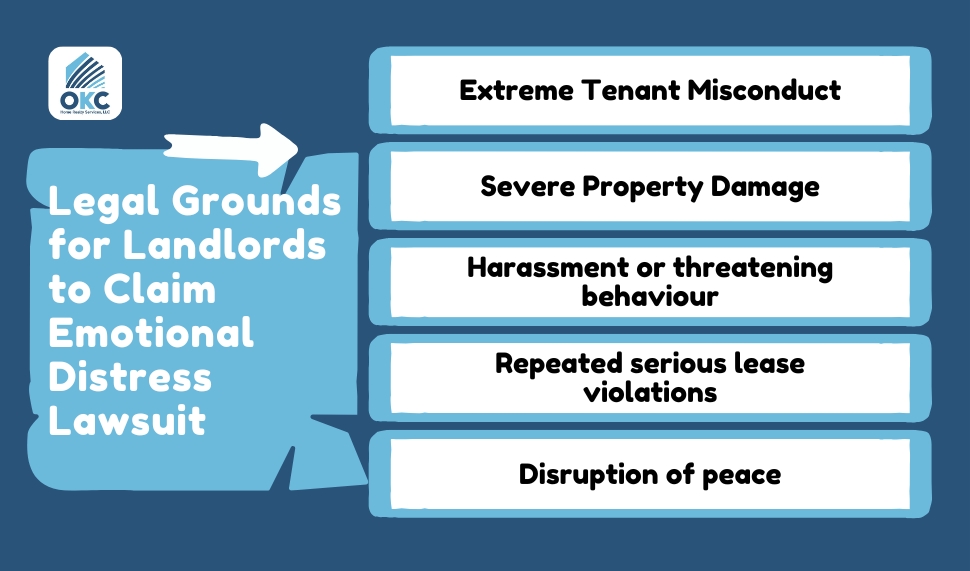Landlord-tenant disputes aren’t a new thing in the housing market. Issues like lease term violations, property repairs and maintenance concerns, or rent payment obligations often arise and in most cases,these problems are resolved through simple communication. However, sometimes disputes escalate beyond simple disagreements, where you may experience significant emotional distress due to a tenant’s behaviour.
In such cases, as a landlord, you may wonder if you can sue a tenant for emotional distress. After all, this is a valid concern as this can lead to serious mental health conditions.
The answer is Yes. You can sue a tenant for emotional distress only if the tenants actions are extreme, outrageous and cause serious mental suffering. However, it can be a complex and time-consuming process, and requires strong evidence to prove the claim.
Keep reading to learn more about the circumstances under which a landlord can sue a tenant for emotional distress, the legal requirements for filing such a claim, and the challenges involved in proving emotional harm.
Maximize Your Rental Income with Hassle-Free Property Management
Request a Service →Key Notes
- Yes, landlords can sue tenants for emotional distress, but only under strict legal conditions.
- Emotional distress lawsuits are based on either intentional or negligent behavior by the tenant.
- Landlords must show outrageous conduct, severe emotional harm, and strong evidence to win.
- These lawsuits are hard to win and often expensive.
- Tenants can defend themselves with documentation, legal help, and even file counterclaims if the landlord acted improperly.
- Courts look for proof like medical records, therapy bills, and witness testimony to support the claim.
- Yes, landlords can sue tenants for emotional distress, but only under strict legal conditions.
- Emotional distress lawsuits are based on either intentional or negligent behavior by the tenant.
- Landlords must show outrageous conduct, severe emotional harm, and strong evidence to win.
- These lawsuits are hard to win and often expensive.
- Tenants can defend themselves with documentation, legal help, and even file counterclaims if the landlord acted improperly.
- Courts look for proof like medical records, therapy bills, and witness testimony to support the claim.
Types Of Emotional Distress Claims
First, let’s understand how many types of emotional distress lawsuits you can claim.
According to the Legal Information Institute, there are two types of emotional distress lawsuits a person can claim under TORT Law.
1. Intentional Infliction of Emotional Distress (IIED)
Intentional infliction of emotional distress means when someone intentionally or purposely does something so extreme and outrageous that it causes another person severe emotional pain or suffering. It usually involves behavior that is shocking or beyond what’s considered acceptable in society.
For e.g., A tenant repeatedly sends threatening messages or confronts the landlord with aggressive behaviour, causing fear and emotional trauma.
2. Negligent Infliction of Emotional Distress (NIED)
Intentional infliction of emotional distress means when someone intentionally or purposely does something so extreme and outrageous that it causes another person severe emotional pain or suffering. It usually involves behavior that is shocking or beyond what’s considered acceptable in society.
For e.g., A tenant leaves doors or windows unlocked, leading to a break-in or damage, which can cause you emotional distress from the financial loss and increased anxiety.
Legal Grounds for Landlords to Claim Emotional Distress Lawsuit

1. Extreme Tenant Misconduct
A lawsuit is possible if your tenant’s behavior is so extreme or outrageous that it causes significant mental suffering. It includes situations where the tenant is continuously disruptive, which goes beyond normal tenant behavior.
For e.g., A tenant who repeatedly sends threatening messages makes false accusations or deliberately creates situations that cause emotional trauma can be considered extreme misconduct.
2. Severe Property Damage
If a tenant causes severe damages to your property with the intent to cause harm or in a reckless manner, it can be grounds for you to file an emotional distress lawsuit. It includes critical or irreparable harm to the property, like breakage of appliances, large holes in walls, destroyed landscapes, etc. For more on what to do in these situations, check out our article on how to handle tenant damage in Oklahoma.
For e.g., a tenant who, upon receiving an eviction notice, purposely breaks windows, damages flooring, and destroys built-in fixtures as an act of revenge.
3. Harassment or threatening behaviour
If your tenant harasses you or displays any behavior that is threatening or abusive, then you can sue your tenant for emotional distress out of fear and anxiety. It includes any verbal threats or physical aggression like pushing, stalking, intimidating gestures, making repeated unwanted contact or visits, etc. Learn how to spot the warning signs and what steps to take in our guide on dealing with tenant harassment.
For e.g., A tenant who continuously shows up uninvited at your residence sends threatening text messages or makes explicit threats about potential violent actions.
4. Repeated serious lease violations
If a tenant violates the terms of the lease(beyond typical minor violations) time and again, even after giving them a warning, it can lead you to headaches and stress. In such cases, you can sue your tenant for emotional distress. It includes any act that goes against your contract, such as unauthorized occupants, repeated noise complaints, illegal activities on the property, failing to pay rent on time despite multiple warnings, etc.
For e.g., a tenant who repeatedly sublets without permission or hosts large and disruptive parties every weekend is restricted in the lease.
5. Disruption of peace
If a tenant’s activities or behavior disturbs your peace and that of other residents and creates unbearable living conditions in the building, then it can be legal grounds for an emotional distress lawsuit. This includes activities like generating ongoing conflicts, spreading malicious rumors, making loud noise, intentionally undermining your reputation, etc.
For e.g., A tenant spreading false rumors about you, suggesting that you are engaged in illegal activities, or damaging your reputation.
Related Read: 7 Warning Signs of a Bad Tenant You Need To Know
Requirements for Proving Emotional Distress
As it is not physical, you can have difficulty in proving emotional distress in court. You have to be extremely careful and must have proper documentation of every possible thing that clearly supports your emotional distress claim.
To prove an emotional distress lawsuit, you need to have:
1. Evidence of extreme and outrageous conduct
Extreme and outrageous conduct means behavior or activities that are shocking or beyond what’s normally acceptable. It includes harassment, threats, or other forms of unacceptable treatment.
To prove emotional distress, you need to give strong evidence of such incidents that cause the emotional trauma. Evidence can include witness statements, text messages or emails, video or audio recordings, photographs, police reports, etc.
Note: Simple rudeness or minor misconduct is not extreme and outrageous conduct. The conduct must be truly severe, going far beyond what is acceptable.
2. Record of intentional or reckless conduct
Intentional or reckless conduct means deliberate actions that are done with a complete disregard for other people’s well-being and emotional safety. It includes persistent harassment, deliberate property damage, repeated lease violations, threats of violence, or systematic attempts to create an unsafe or hostile living environment.
To support your emotional distress claim, you need to provide a record of such activities. Documentation such as emails, text messages, maintenance records, and witness statements can help establish a pattern of intentional or reckless behavior.
3. Documented Mental Health Impact
You must prove that your tenant’s actions caused a real impact on your mental health. To show this, medical documentation supported by a licensed health professional is critical. You can show your psychiatric reports or therapy records that clearly demonstrate your mental suffering and the treatment you are having.
For e.g., if you start experiencing panic attacks or insomnia due to your tenant’s actions, a doctor’s note confirming this impact can help support your claim.
4. Clear connection between tenant’s actions and your’s distress
You can’t simply claim emotional distress without demonstrating a clear connection between the tenant’s actions and the distress you’re experiencing. You must provide concrete evidence that clearly shows how the tenant’s behavior directly caused your mental and emotional trauma. Any emotional suffering from external factors or pre-existing conditions doesn’t qualify for the claim and, thus, should not be considered.
For e.g., if you lose sleep due to your tenant’s repeated late-night phone calls, you can show that the distress came directly from the tenant’s actions.
Maximize Your Rental Income with Hassle-Free Property Management
Request a Service →Landlord Liability: Can Tenants Sue Landlords for Emotional Distress?
Landlords have a legal responsibility to ensure that their rental property is safe, habitable, and free from harassment or discrimination. When a landlord’s actions, or lack of action, cause significant emotional distress to a tenant, the tenant may have grounds to file an emotional distress lawsuit. This can include cases of intentional infliction of emotional distress, such as when a landlord harasses, threatens, or intimidates a tenant, as well as negligent infliction of emotional distress, such as failing to address unsafe living conditions or ignoring necessary repairs.
To succeed in such a claim, tenants must prove that the landlord’s conduct was the direct cause of their emotional suffering and that the distress was significant. Consulting with experienced attorneys who specialize in landlord-tenant law is crucial, as they can help tenants understand their rights, gather the necessary evidence, and navigate the legal process. Whether the infliction of emotional distress was intentional or due to negligence, tenants should seek legal counsel to determine the best course of action for their unique situation.
Example: Tenant Wins Emotional Distress Claim
Case: Cory Dostie (nonbinary tenant) vs. Andrew Marowitz (landlord)
Jurisdiction: California Supreme Court, February 2025
Facts:
- Dostie, a nonbinary tenant, was repeatedly misgendered, mocked, and denied accommodations after gender-affirming surgery by their landlord.
- They sued under state civil rights law, claiming emotional distress along with discrimination.
Outcome:
- The court awarded $30,000 in emotional distress damages (plus $10,000 civil rights compensation and $20,000 punitive damages).
- The court affirmed that intentional misgendering causing mental harm qualifies as “outrageous conduct” under IIED standards.
(Source: sfchronicle.com)
Legal Process in Emotional Distress Claims
The legal process in emotional distress claims is very complex and time-consuming. Most importantly, since emotional harm is intangible, proving it requires strong evidence and careful legal steps.
1. Consult with an Attorney
The first step is to consult a lawyer specializing in landlord-tenant dispute law. It’s critical to seek legal advice regarding your issue before going forward with any legal action. An experienced attorney can help you understand your rights, assess the strength of your emotional distress claim, and provide guidance on the evidence needed to support your case.
2. Gather Evidence
The next step is to gather all the evidence that can support your claim as per the guidance of your attorney. Evidence could include witness statements, medical records, communication such as emails or text messages, police reports, photographs, or any other documentation that proves the defendant’s actions and the emotional harm caused.
3. File the Lawsuit
Now, you have the appropriate knowledge about the legal procedures and all the evidence to support your claim in hand. It’s time to file the lawsuit in your appropriate jurisdiction, as advised by your legal counsel.
Legal Challenges in Emotional Distress Claims
As emotional distress is not physical harm, proving it in court can be extremely difficult and challenging. Legal disputes over emotional distress claims can take a significant emotional toll on landlords, as the process often involves stressful litigation and the risk of escalating conflicts. Some challenges you may have to face while claiming an emotional distress lawsuit are:
1. High burden of proof
As emotional distress is intangible, proving it in court can be a challenging task for you. You are required to provide concrete evidence to the court that psychological harm occurred due to your tenant’s actions. This includes providing medical records, psychiatric evaluations, or expert testimony that clearly shows the link between your emotional distress and the incident. The court may dismiss the claim as baseless or unsubstantiated without solid evidence.
2. Potential countersuit risks
Proving emotional distress is hard. If you can’t back up your claim properly, you open the door to potential countersuit risks from your tenants. Your tenant can counter your claim, questioning the legitimacy of your emotional suffering and accusing you of defamation or false accusations. This could make the case more complicated and increase your legal costs, which can put additional psychological strain on you.
3. Expensive litigation process
An emotional distress lawsuit is an expensive litigation due to its complex nature. Attorney fees, expert witness charges, documentation costs, psychiatric evaluation costs, court fees, etc. These costs can financially drain you. Additionally, the process can be time-consuming, stretching over months or even years. There is a higher chance that the financial investment required might outweigh the potential compensation, making the case challenging for you to pursue.
4. Difficult quantifying emotional damages
Emotional damages are not physical things and thus don’t have a clear monetary value. It’s a challenging aspect of an emotional distress lawsuit to determine the appropriate amount of compensation for emotional suffering. The court relies on subjective interpretations of pain and suffering, like intensity of emotional trauma, duration of distress, medical bills for therapy, loss of work or impact on personal and professional life, expert testimony, and personal journals, but these estimates can vary widely.
How OKC Home Service Can Help You
Proving an emotional distress claim in court can be a challenging task. Since emotional pain is not something that can be seen or touched, you are already equipped with a high burden of proof to support your claims. And this is one of the reasons why such cases have a very low success rate.
More importantly, such legal procedures will cost you a lot of time, energy, and money, which may not be worth it. That’s why resolving the issue within yourself should be your priority before taking any legal path.
But if you are still considering suing your tenant, it’s best to seek professional help like OKC Home Realty Services, LLC.
With 15+ years of experience in property management, we can help you evaluate the situation properly and manage all the required legal documents. We can also provide guidance on moving forward and better strategizing your legal approach while complying with legal procedures before escalating to litigation.
Maximize Your Rental Income with Hassle-Free Property Management
Request a Service →FAQs About Suing Tenants for Emotional Distress
What is Emotional Distress?
Emotional distress is any suffering or pain a person goes through mentally and emotionally caused by some bad incidents or traumatic experience. Emotional distress can have a very bad impact on someone's health and overall functioning.
Can I sue the tenant for Damages Beyond the Security Deposit?
Yes, you can sue for damages beyond the amount of the security deposit. This is a common legal right for landlords, as tenants are generally responsible for any damages they cause beyond normal wear and tear, regardless of the security deposit amount.
Can I sue a Tenant for Breach of Contract?
Yes, you can sue a tenant for breach of contract if your tenant fails to adhere to the terms and conditions outlined in the lease agreement.
Can I sue for Damages without a Lease?
Yes, a landlord, you can sue a tenant for damages even without a written lease. This is because when a tenant occupies the property and pays rent, an implied agreement is established. However, proving the terms of the agreement and the extent of damage can be more challenging without a formal lease agreement.
What is the Amount You Can Sue for Emotional Distress?
The amount you can sue for emotional distress depends on several factors, such as specifics of the case, intensity of the distress and the jurisdiction.

Author
Scott Nachatilo is an investor, property manager and owner of OKC Home Realty Services – one of the best property management companies in Oklahoma City. His mission is to help landlords and real estate investors to manage their property in Oklahoma.
 (
(









